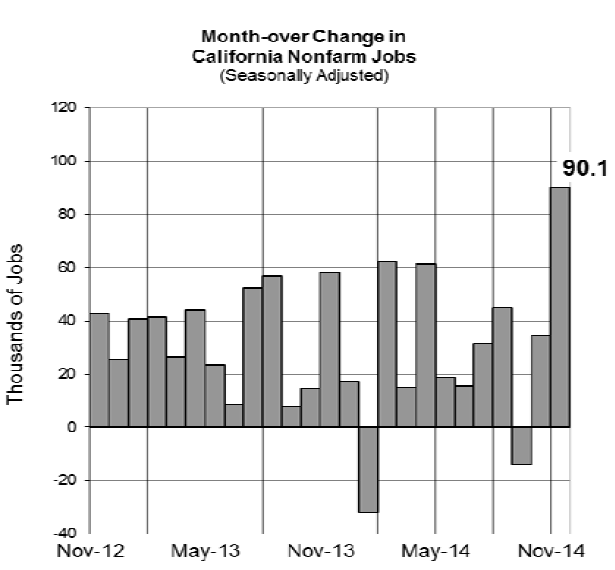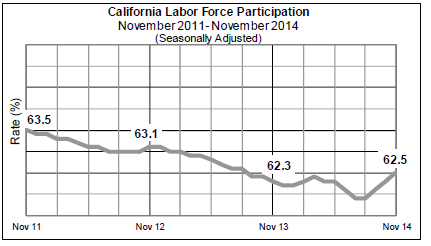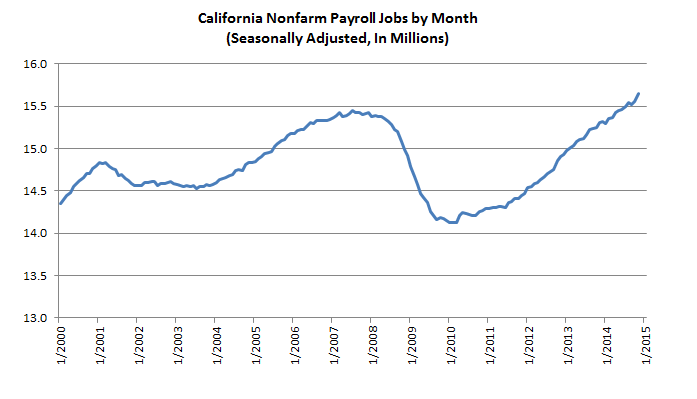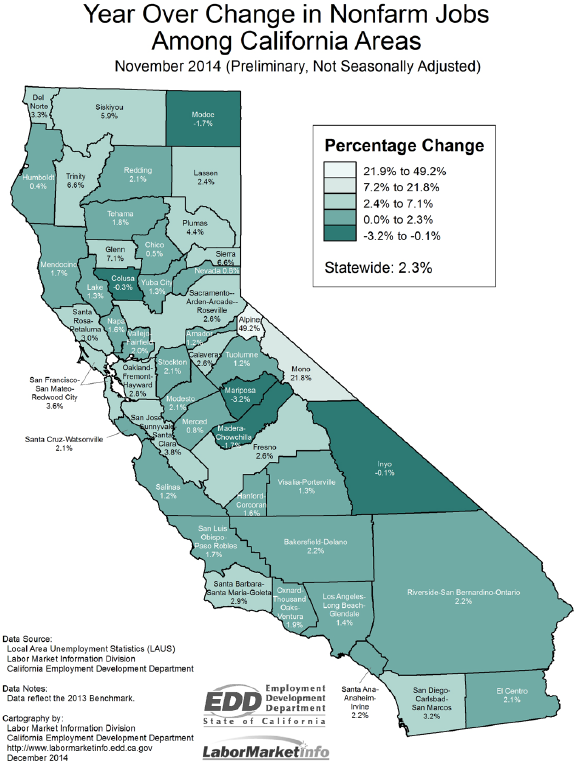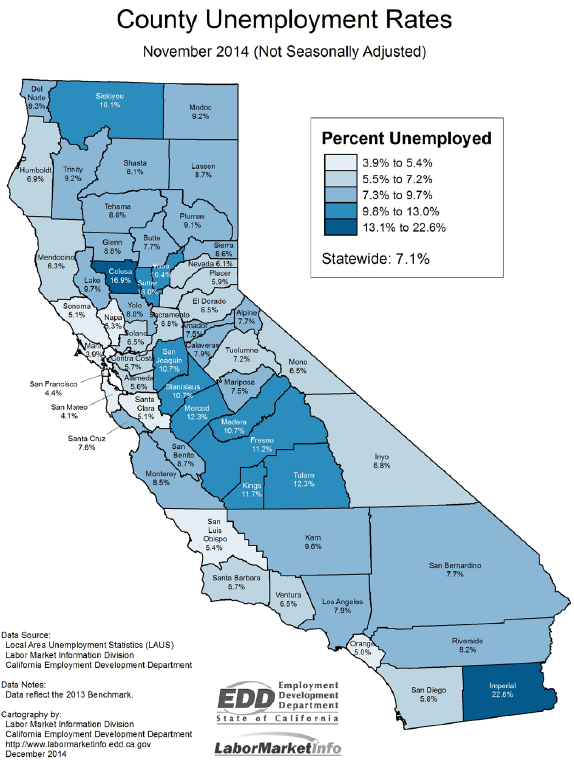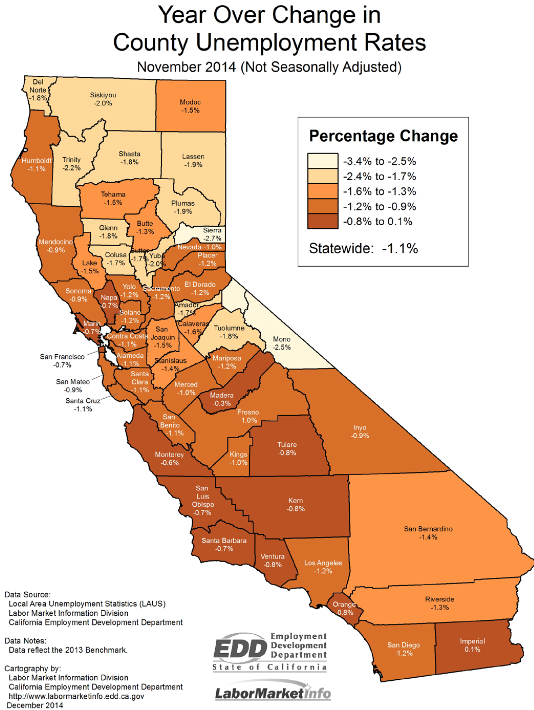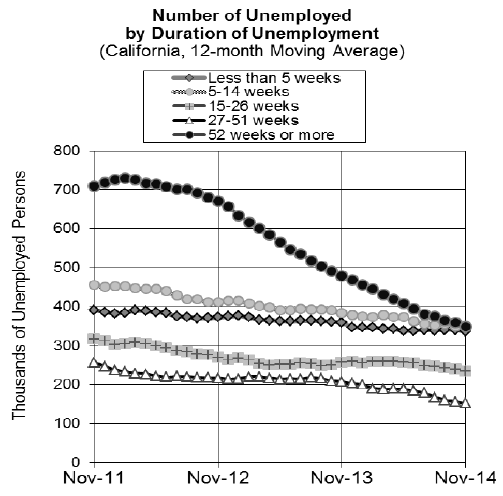The Employment Development Department (EDD) monthly California jobs report is now online, with the EDD press release here. EDD reports that California's unemployment rate dropped from 7.3 percent in October 2014 to 7.2 percent in November 2014. (One year ago, in November 2013, the unemployment rate was 8.4 percent in California.) As shown in the EDD graphic below, nonfarm payroll jobs surged by 90,100 during the month for a total gain of 1.5 million jobs since February 2010, EDD said. The preliminary figure for monthly job growth, 90,100, appears to represent the second-highest level of monthly seasonally-adjusted job growth for California since 1990 (in October 2012, jobs increased by 111,000).
LAO Bottom Line. Our office's point of view is that this monthly jobs report looks good across the board. During the 2014-15 state fiscal year (through November 30), personal income tax withholding is up from the same period last year by a very strong 9 percent, and this monthly jobs report seems consistent with that trend. While the state is not going to add 90,000 jobs every month and still has much higher unemployment than most other states, California and the U.S. seem well poised for another good year of job growth in 2015.
- Strong Construction Job Growth. November construction jobs were up by a very strong 12,900, compared to October. In our November Fiscal Outlook, we cited uncertainties about housing, including construction jobs, as a big question mark for the economy, so these figures seem like good news.
- Strong Professional and Technical Services Job Growth. Jobs in this key subsector were up 11,600, compared to October. A related sector that includes other parts of the state's technology industry, information, was up by 1,800 to the highest level of jobs since 2008.
- Labor Force Growing Faster Than Working Age Population. The jobs report's "household survey" (used to determine the official unemployment rate) shows that the civilian labor force in California has grown 1.4 percent since last November. It appears that the labor force is growing faster than the working age population, as shown in the growing labor force participation rate displayed below. Long-term unemployment (52 or more weeks) and measures of the "discouraged" potential labor force both have declined from last year, which is positive news for California.
- Continued Expansion After Deep Recession-Period Drop in Jobs. It took California about seven years to regain the number of jobs lost during the severe recession that began in 2007. As shown below, California has now more than fully recovered the number of jobs lost during the recession.
Other data is available at EDD's Monthly Data Release website. Selected EDD graphics are shown below:
- Job Growth Since Last November by Region. In the EDD map below, a lighter shade indicates a higher job growth rate since November 2013.
- Job growth rates in The Bay Area and San Diego have been leading the state's job expansion over the past year.
- Job growth in the Sacramento and Fresno regions also has been above the statewide average.
- Job growth in Orange County, the Inland Empire, and the Bakersfield, Stockton, and Modesto regions has been at about the state average.
- Over the past year, non-seasonally-adjusted job growth rates in Los Angeles County, the state's largest, have trailed the statewide average.
- The data also shows that a number of northern and Sierra Nevada rural counties have recorded large percentage growth in jobs over the past year. (Non-seasonally-adjusted data from some of these counties, however, can be heavily influenced by seasonal hiring in tourism and other industries.)
- Unemployment Rates by County. In the EDD map below, a lighter share indicates a lower county unemployment rate. Non-seasonally-adjusted unemployment rates in November 2014 ranged from a low of 3.9 percent in Marin County to a high of 22.6 percent in Imperial County.
- Change in Unemployment Rates by County Since Last Year. In the EDD map below, a lighter shade indicates a bigger drop in the unemployment rate since last November.
- Change in Unemployed by Duration of Unemployment. In the EDD graphic below, note that the number of long-term unemployed (52 weeks or more) has fallen considerably from prior years.
- Change in Labor Force Discouragement Statistics. In the EDD figure below, note the decline since last year in various measures of the discouraged potential labor force. For example, the number of those not in the labor force (not able, available, and actively looking for work), but who wanted a job anyway, is down 4.4 percent from one year ago.
Below is information from the U.S. Bureau of Labor Statistics (BLS):
- California Still Has Second Highest State Unemployment Rate. Recovering from the very deep recession, California's economy still has a relatively high level of unemployment, compared to the rest of the U.S. BLS data shows that California's 7.2 percent unemployment rate in November ties with Georgia for the nation's second worst state unemployment rate. Mississippi's unemployment rate is 7.3 percent, while Washington, D.C. has a 7.4 percent unemployment rate.
- California Unemployment Rate Falling Faster Than Most Other States. California's unemployment rate drop in the past year has been larger, in percentage points, than the drop in 33 other states, BLS data shows. California's unemployment rate has dropped 5.2 percentage points from its 12.4 percent high in October 2010.
- California Payroll Jobs Growing at Faster Rate Than Most Other States. From November 2013 to November 2014, California nonfarm employment has grown by 344,100, up 2.2 percent. This 2.2 percent job growth rate over the past year ranks California 14th among the states, behind North Dakota (up 4.8%), Texas (up 3.9%), Utah (up 3.4%), Florida (up 3.0%), Oregon (up 3.0%), Delaware (up 3.0%), Washington State (up 2.8%), North Carolina (up 2.6%), Arizona (up 2.6%), South Carolina (up 2.6%), Georgia (up 2.4%), Colorado (up 2.3%), and Nevada (up 2.3%).

